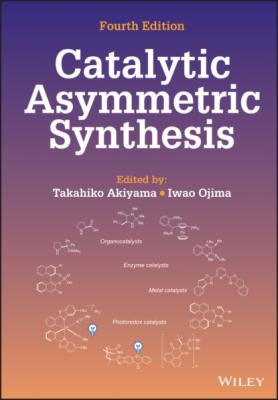Catalytic Asymmetric Synthesis. Группа авторов
Чтение книги онлайн.
Читать онлайн книгу Catalytic Asymmetric Synthesis - Группа авторов страница 32
 (1.14)
(1.14)
1.3.5. Dienamine and Trienamine as an Intermediate [33]
Enamine chemistry was extended to dienamine chemistry: diarylprolinol silyl ether reacts with an α,β‐unsaturated aldehyde to generate an iminium ion, which is further converted into a dienamine. As dienamines are electron‐rich, they act as reactive dienes in the Diels‐Alder reaction. The 1,4‐position of the original aldehyde reacts with a dienophile. Jørgensen reported the reaction of a dienamine with azodicarboxylate, in which only the s‐cis dienamine from a mixture of s‐cis and s‐trans isomers reacts in a concerted fashion (Diels‐Alder reaction) to afford the product with excellent enantioselectivity (Eq. 1.15) [34].
A dienamine is successfully utilized in the enantioselective synthesis of a key intermediate of 14β‐steroids by the reaction of an enal with a cyclic dienophile in the presence of diphenylprolinol silyl ether (Eq. 1.16). This reaction allows easy access to an optically active steroid core with a variety of substituents in the A ring in high yields and up to more than 99% ee. (+)‐Estrone was efficiently synthesized by using this reaction as a key step [35].
This dienamine system was further extended to trienamine chemistry. Chen and Jørgensen reported the generation of an electron‐rich trienamine from a polyconjugated 2,4‐dienal. By a reaction with a dienophile, a cycloaddition reaction proceeded to afford a spirocyclic oxindole possessing a cyclohexene moiety with an exclusive β,ε‐regioselectivity and excellent stereoselectivity (Eq. 1.17) [36].
1.4. IMINIUM ION
1.4.1. Introduction of an Iminium Ion
MacMillan reported the Diels‐Alder reaction using a chiral imidazolidinone, which reacts with an α,β‐unsaturated aldehyde to afford an iminium ion. The iminium ion is a highly electron‐withdrawing group; its alkene has a lower LUMO level than the parent α,β‐unsaturated aldehyde. Thus, the Diels‐Alder reaction proceeds via the iminium ion intermediate not from the α,β‐unsaturated aldehyde. By the appropriate design of the chiral amine moiety, an enantioselective reaction can be realized. In fact, the chiral imidazolidinone catalyst afforded an excellent enantioselectivity (see above; Eq. 1.3) [4]. Many reactions have been developed involving the iminium ion as a key intermediate.
1.4.2. Two Reaction Paths
Two reaction paths, Diels‐Alder type reaction and Michael reaction, involve an iminium ion as a reactive intermediate [37]. These two reaction paths will be discussed in the reactions of cinnamaldehyde and cyclopentadiene catalyzed by diarylprolinol silyl ether (Table 1.1).
The Diels‐Alder reaction was catalyzed by diarylprolinol silyl ether 6, with trifluoromethyl groups on the aryl moiety (Figure 1.6) with a combination of a strong acid such as CF3CO2H [38]. It should be noted that the exo‐isomer was obtained predominantly.
On the other hand, when a mixture of cinnamaldehyde and cyclopentadiene was treated with diphenylprolinol silyl ether 5 (Figure 1.6) with a combination of p‐nitrophenol or NaOAc, Michael products were obtained with excellent enantioselectivity without formation of the Diels‐Alder products [39]. Iminium ions are key intermediates in both reactions.
As the pyrrolidine moiety of catalyst 6 is more electron deficient than that of catalyst 5 because of the electron‐withdrawing CF3 group, the LUMO of the iminium ion generated from 6 is lower than that of the iminium ion generated from 5. The Diels‐Alder reaction proceeds smoothly when the LUMO of the dienophile is lower. Thus, the Diels‐Alder reaction proceeded in the case of 6 (Scheme 1.3). On the other hand, in the Michael reaction (Scheme 1.4), after the formation of the iminium ion, counterion (OH−) reacts with p‐nitrophenol to generate phenoxide, which reacts with cyclopentadiene to generate an anion of cyclopentadiene. This anionic nucleophile reacts with the iminium ion to afford the Michael product. For the generation of anionic nucleophile, the nucleophile is limited to the active methylene compounds, and a strong acid cannot be employed.
TABLE 1.1. The two reaction paths in the reaction of cinnamaldehyde and cyclopentadiene
|
|
||||||||
| 3 | 4 | |||||||
| Catalyst | Solvent | Additive | Yield/% | a:b | ee/% | Yield/% | exo/endo | ee/% |
| 5 | MeOH | p‐nitrophenol | 84 | 70 : 30 | 92 | 0 | ||
| 5 | MeOH | NaOAc | 81 | 64 : 36 | 92 | 0 | ||
| 5 | toluene |
| ||||||